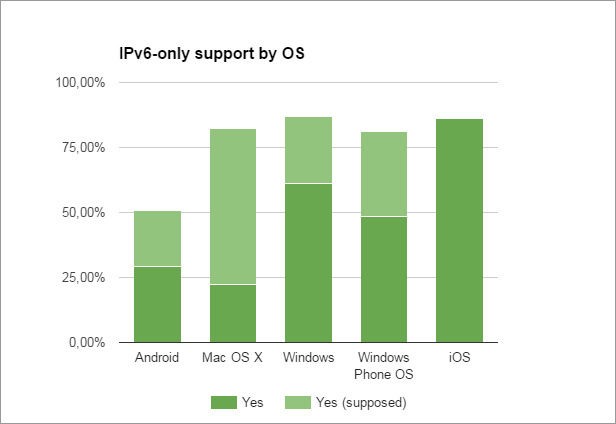Let’s suppose I decide to run an IPv6-only public hotspot: how many users would be able to surf the web with no troubles? That is, how many devices nowadays run OSs which are able to work out of the box without an IPv4 address?
What this post is / is not
This post does not pretend to be a deep technical analysis of IPv6-only networks and their problems, nor to reflect implementation flavors from different vendors; it’s just meant to give a coarse idea of the IPv6-only readiness status among some of the most used devices as it emerges from a collection of user-reported experiences I have collected here and there.
Just to better describe what I mean, this is the very limited definition of “able to work with no IPv4 addresses” that I kept in mind here: a device that, once instructed by the user, connects to the LAN and allows him/her to open the browser and to surf the IPv6-enabled slice of the web, with no need of hacks, manual configuration, nor long waiting time for fallback mechanisms but providing an user experience directly comparable with the traditional IPv4 or dual-stack networks.
I know, this is just the smallest part of what an user expects from a smartphone or from a laptop, but it allows to set the low bar: a device that with no IPv4 addresses can’t even connect to the network is out of the picture.
In particular, with LAN I mean a network with only a router which supports provision of IPv6 global addresses via SLAAC, RDNSS (rfc6106), DHCPv6 DNS_SERVERS option (rfc3646). WAN/mobile connections are out of the scope of this post.
Results
Disclaimer: what I put together here is a collection of experiences from the field as they have been reported by others, grouped by operating systems versions and correlated to their spread. Some information are missing and – mostly – I could not verify the majority of them, so: please be careful before using these results for any business decision and consider reading the information sources I referenced within the document.
IPv6-only support by OS (last update: 2016-08-08)
Everything is up on a Google Sheets document:
Here you can find the document. YMMV!
Please feel free to share your experience and to suggest any improvement I could make.
Data sources
OSs distribution
- Android: Android Developers
- iOS: Apple Developer
- Mac OS X, Windows, Windows Phone OS: NetMarketShare
Info sources
- ipv6-wg RIPE Mailing Lists
- Android Open Source Project, Issue 32630
- Experiences from IPv6-Only Networks with Transition Technologies in the WIDE Camp Autumn 2012, draft-hazeyama-widecamp-ipv6-only-experience-02
- Apple Developer
- Experiences from an IPv6-Only Network, rfc6586
- IPv6Int.net
- Microsoft TechNet
Latest posts by Pier Carlo Chiodi (see all)
- Good MANRS for IXPs route servers made easier - 11 December 2020
- Route server feature-rich and automatic configuration - 13 February 2017
- Large BGP Communities playground - 15 September 2016
Leave a Reply